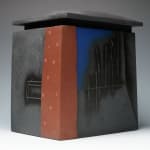Hayashi Yasuo 林康夫 Japanese, b. 1928
H29.5 x W26 x D22.3 cm
Further images
-
(View a larger image of thumbnail 1
)

-
(View a larger image of thumbnail 2
)

-
(View a larger image of thumbnail 3
)

-
(View a larger image of thumbnail 4
)

-
(View a larger image of thumbnail 5
)

-
(View a larger image of thumbnail 6
)

-
(View a larger image of thumbnail 7
)

-
(View a larger image of thumbnail 8
)

-
(View a larger image of thumbnail 9
)

-
(View a larger image of thumbnail 10
)

-
(View a larger image of thumbnail 11
)

-
(View a larger image of thumbnail 12
)

During this historical juncture in Japan, ladders emerged as prevalent motifs in graphic design, geometric abstraction, and various artistic movements influenced by Western trends. The ladder motif, with its dual aspects, encapsulates both a representation of construction and industry, and a symbolism of growth and progress. The juxtaposition of these elements suggests a nuanced exploration of the evolving mindset during the postwar era in Japan.
The presence of such a motif may be interpreted as a collective expression of the prevailing mentality and a shared desire among artists to forge new artistic and social identities independent of traditional constraints. In this context, the use of the ladder motif becomes a visual language conveying the era's aspiration for innovation and departure from convention, reflecting a transformative period in Japanese artistic history. In this context, Hayashi Yasuo founded the avant-garde sculptural ceramics movement "Shikokai".
In essence, Shikokai's ceramic objects are intricately connected to the abstraction of automatism. This means that the method of creation is not grounded in detailed drawings or plans but relies on rough images or extremely sketchy outlines.
The artist determines the form as it unfolds before their eyes during the object's creation. While ceramics impose more restrictions compared to painting, this mindset of "thinking while making" has profoundly broadened the scope of expression in ceramic art.











